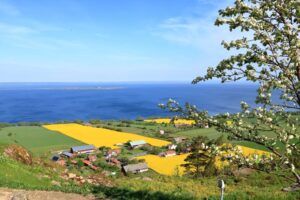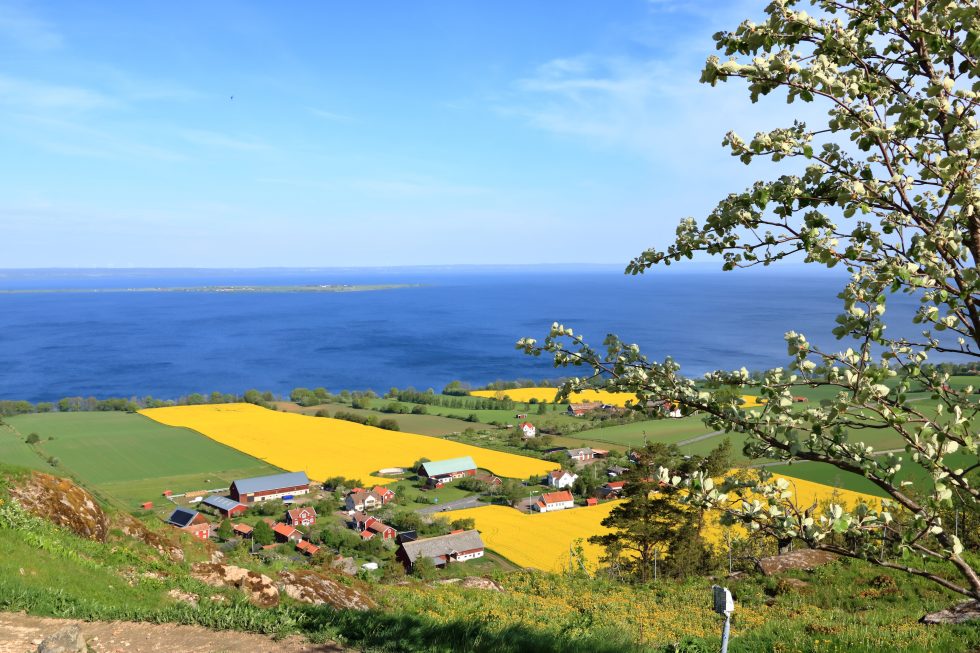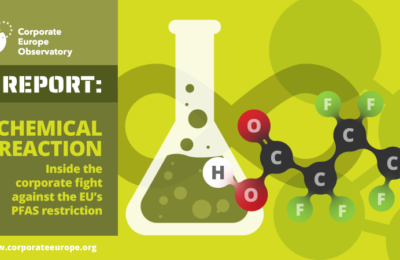
The Norra Karr deposit of rare earth elements (REE) is situated in the southern part of Sweden, on the picturesque shores of Lake Vattern, one of the largest lakes on the Scandinavian Peninsula. The lake is surrounded by a unique mountain landscape, some of which is protected by the European Union’s Natura 2000 program. Vast reserves of fresh water coexist here with equally immense reserves of rare earth elements, which are now deemed critical for the transition to renewable energy.
According to local resident and activist Carina Gustafsson, Lake Vattern provides drinking water to 500,000 households. Approximately 260 farms and homes located within a two-kilometer radius of the proposed mine are dependent on the lake’s water supply, as well as a rich biodiverse landscape around the lake.
This 110-million-ton mineral deposit is estimated to contain approximately half a million tons of REE comprising both heavy and light elements found in eudialyte and catapleiite minerals embedded in granite. The deposit, located on the edge of a tectonic plate, is a very complex deposit containing more than 80 different minerals, which renders open-pit extraction problematic, according to Gustafsson. Yet, Greena Mineral AB, a Swedish subsidiary of Canadian Leading Materials Ltd., has specified “conventional open-pit drill and blast” as the primary method for extraction.
The development of such a deposit situated 1.5 kilometers from the lake’s shoreline and up to 120 meters above its level, Gustafsson says, poses a threat to the unique Natura 2000 protected ecosystems. Because it takes 60 years for the lake’s water to be completely replaced due to slow water exchange, extraction of the minerals may lead to irreversible pollution of the lake. She asserts that this deposit, along with others of a similar nature, contains earth metals in immediate proximity to toxic radionuclides such as uranium and thorium, as well as lead and asbestiform minerals. She fears that these toxic elements won’t be removed but rather left in the waste to be stored onsite.
The development of this deposit began to be discussed in 2009. However, because of the actions of the local government, activists, and organizations, as well as procedures under Swedish law, it was halted. Activists fear that the forgotten plans may resurface soon enough, under the guise of concern for climate and sustainability. They worry that this can lead to the wrecking of freshwater sources and local biodiversity, which are critically vulnerable in the face of global warming. Leading Materials Ltd. has already announced its intention to obtain a mining license after accomplishing the Natura 2000 Protected Area Impact Study.
Consequences of Open-Pit REE Mining
Recent Life Cycle Assessments showed that REE mining is still associated with large quantities of chemicals needed for processing and large amounts of tailings containing toxic radionuclides Th-232 and U-238 and their decay products. These radioactive elements can enter the environment through air, wastewater, and rain leaching. According to a recent report by Northern Confluence, mining is already a major source of environmental harm in British Columbia, causing water pollution and impacts to sensitive species, while insufficient reclamation, poor waste management, and risks of dam failures worsen the environmental liabilities.
The infamous case of rare earth mining in Bayan’obo, Inner Mongolia, China, has raised a debate about how the environmental risks of rare earth mining measure up against their environmental and climate benefits. The main concern here is not only the harm from local pollution with chemicals, radionuclides, and heavy metals, but also the destruction of vulnerable ecosystems and cultural and historical heritage, as well as habitats for local residents and indigenous peoples. According to journalist Claire Asher, this is the result of open-pit mining, which is most typical for rare earth metals.
EU Critical Raw Materials Act
The transition to renewables has raised legitimate concerns regarding the environmental impact of “front-end” processes like mining. This issue is especially pronounced in countries where mining has historically been established, such as the United States and Sweden. In the United States, mineral exploration is governed by the Mining Law of 1872, which Deputy Assistant Secretary for Land and Minerals Management Steve Feldgus has criticized as “inadequate” and an obstacle to environmentally and socially responsible domestic mining. Similarly, Sweden, as one of the EU’s leading producers of ores and metals, operates under the Minerals Act, which has faced criticism for its perceived inadequacy in protecting the rights of the indigenous Sami people.
However, Sweden has implemented significant environmental legislation, including the Environmental Code, which mandates an environmental impact assessment procedure for mineral exploration projects. This legislation played a pivotal role in halting an earlier REE mining project at the Norra Karr mineral deposit near Lake Vattern.
According to Carina Gustafsson, the company abandoned its extraction plans in 2016 due to its inability to prepare an appropriate Environmental Impact Statement (EIS). In February 2016, the Swedish High Administrative Court revoked the company’s mining concession following an appeal from her organization and others. The company was ordered to submit a comprehensive EIS addressing all environmental impacts, including those on Natura 2000 protected areas. However, the county administrative boards, city councils, and several other stakeholders rejected the company’s slightly updated EIS as insufficient and incomplete. The Swedish Mining Inspectorate then demanded that the EIS be completed, but apparently this had yet to be done.
The situation is expected to change if the new EU Critical Raw Materials Act (EU CRMA) is adopted. Gustafsson is worried that this regulation will open a backdoor for the mining industry, granting easy access to the Norra Karr deposit. This concern arises from the potential simplification of the permitting process in favor of “mining project promoters,” circumventing the existing procedures required by the current national environmental legislation. The proposed legislation states that the extraction of materials from the critical minerals list should be classified as an overriding public interest. “To me, it should definitely be clean freshwater that holds that classification!” says Gustafsson.
Major environmental NGOs, such as Friends of the Earth Europe, consider industrial lobbying the main reason behind the European Commission’s introduction of the new regulation, which facilitates REE mining. According to their July 2023 report, the new CRM Act will allow the industry to self-regulate, a concession to an industry that spends over 21 million euros annually on lobbying.
The motivation behind industrial lobbying stems from industry’s dissatisfaction with current environmental legislation, which diminishes the competitiveness of raw materials mined in the EU, Canada, and the United States compared to those from China and other countries where mining operations are not so strictly regulated. Indeed, Leading Materials Ltd. blames environmental legislation for the denial of their mining permission at Norra Carr. Thus Filip Kozlowski, the company’s CEO, characterized the current legal framework as “prohibitive of efficient permitting processes for mining projects” and that the company will continue to adapt their path “should the legal framework evolve going forward.” Further, the company promised “to go above and beyond compliance in all elements of ESG in order to progress to an EU-based sustainable operating mine.”
The Centre for Research on Multinational Corporations (SOMO) notes that the proposed EU regulation on Critical raw materials is motivated by nothing other than economic reasons. Indeed, the legislation is full of references to price vulnerability and guarantees of economic sustainability that businesses are looking for. But it does not explain why the rare earth mining business can override public interest. According to SOMO, the measures proposed in the Act are a way to turn state institutions into facilitators for industry access to financial resources and mineral deposits by overriding the current key environmental provisions.
Sustainable Way Out
The environmental risks associated with mining rare earth metals create a potentially deadly trade-off: transitioning to renewable energy in order to reduce the burden on the climate and environment requires the extraction of critical minerals that in turn destroys the environment. One way out of this vicious circle would be energy conservation combined with the extraction of rare earth elements from historically accumulated industrial waste and tailings from old mining.
The latter, urban mining, is not yet an established, cost-effective method. The proposed EU act includes measures to encourage urban mining. At the same time, as long as a backdoor exists for industry to access currently inaccessible deposits by undermining existing environmental legislation, traditional mining will go forward. This traditional mining promises quick profits even as it sacrifices the environment in the name of saving the planet.
The mining industry advertises its “climate and environmental concerns.” If open pit mining were environmentally friendly, why would mining companies find environmental regulations so problematic?



